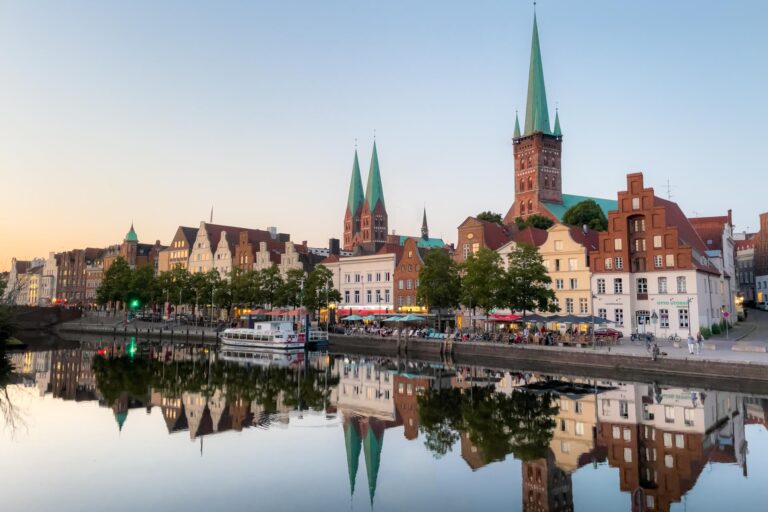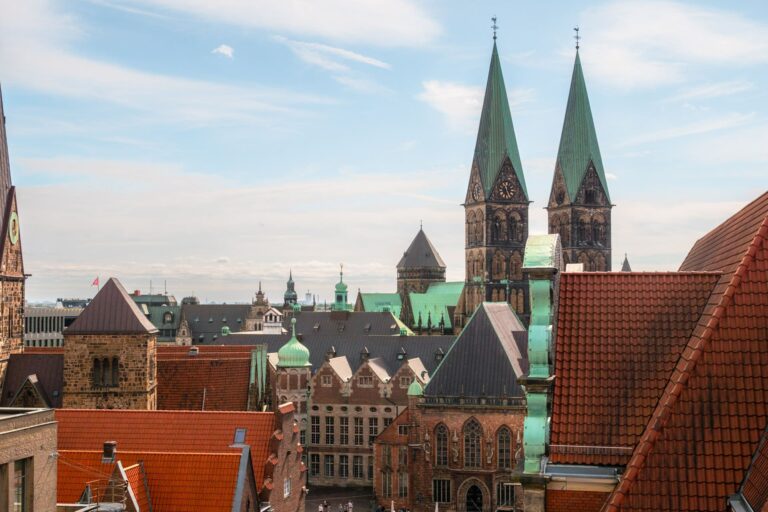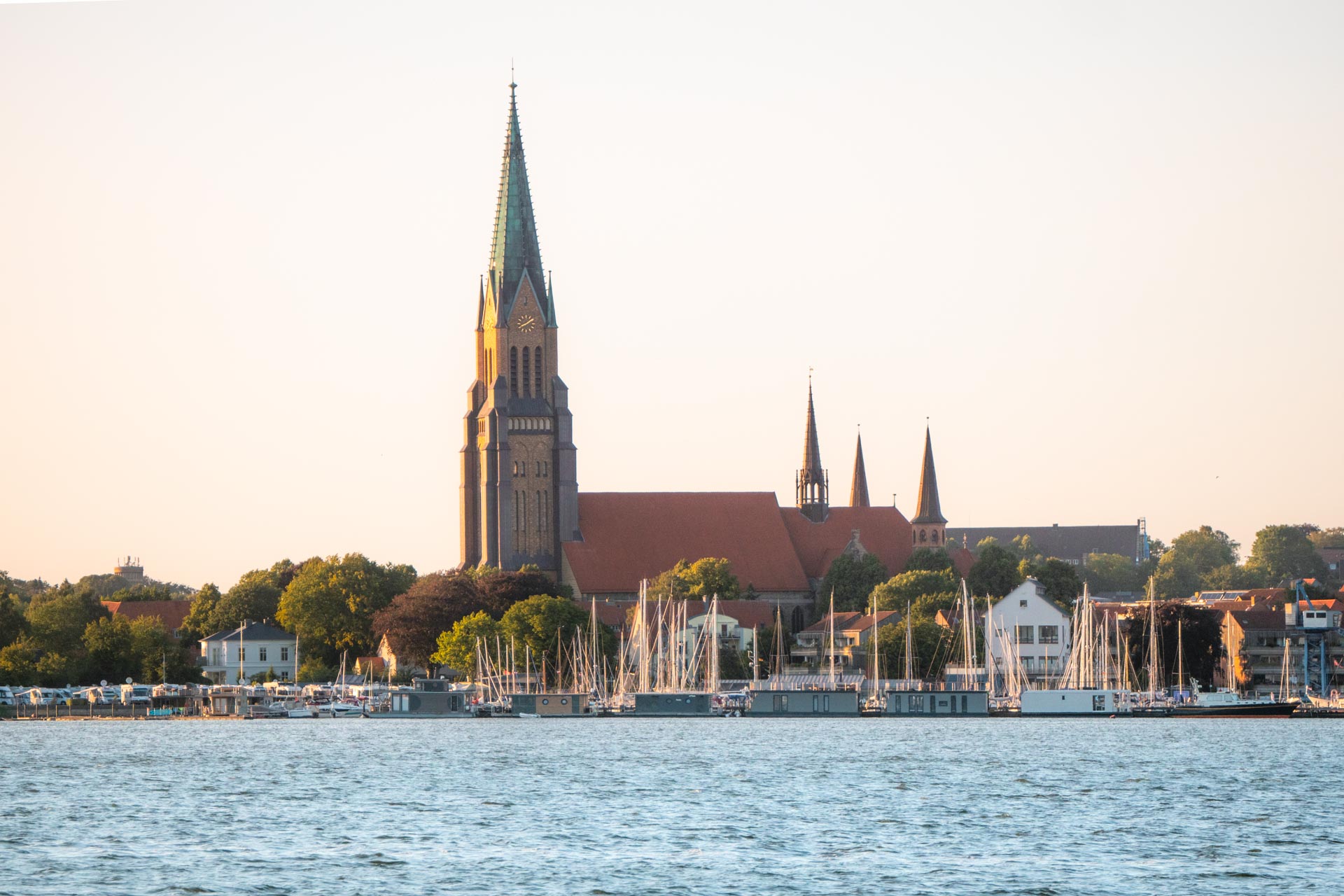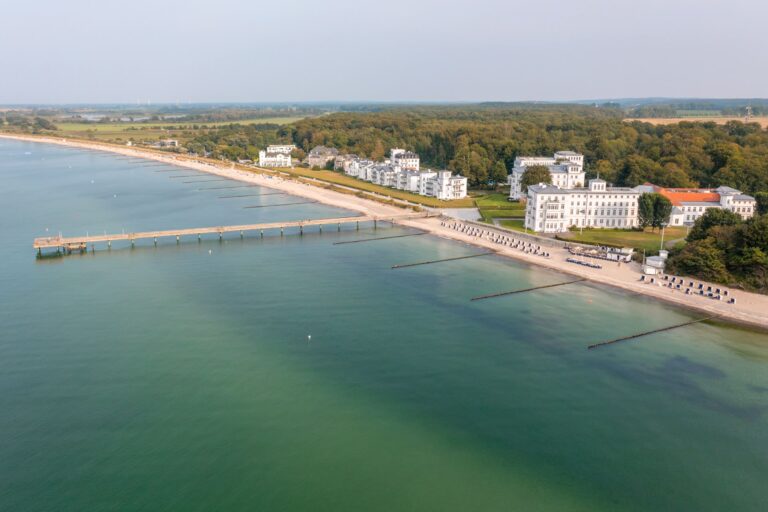Schleswig Travel Guide: 12 Best Things To Do & See in the Historic Viking City
Everything you need to know about Schleswig city including what to do, when to visit and where to stayA hidden gem in Northern Germany
Despite giving its name to the state, “only” 27,000 people live in Schleswig, which makes especially Kiel, Lübeck and Flensburg many times larger.
But Schleswig easily outperforms its size and can rival those three cities with its huge cathedral (which is also taller than it “should be” based on its base!), its medieval castle turned Renaissance fortress turned Baroque castle and last but surely not least its interesting Viking past.
All of this history is perfectly reflected in the calm waters of the Schlei Inlet (also called the Sly Firth), the shores of which you can spend many hours discovering by bike or by foot – until you jump in from one of the charming beaches.
If all of this sounds like a potentially crowded experience, rest assured that Schleswig is still (mostly) a small dot on the international tourist radar even at the height of the high season…
At least until the world discovers what kind of Northern German gem it has been missing out on!
In this travel guide to Schleswig, we share the best things to do and see, why you should visit, where to stay, when to visit, how to get around, our best travel tips and much more.
Where to stay in Schleswig:
- Budget: Hotel Zollhaus – Comfortable double rooms with a central location.
- Value for money: Hotel Alter Kreisbahnhof – Where we stayed in Schleswig.
- Luxury: Hotel Strandleben – Luxury living with direct access to the Schlei.
Search for the best value accommodation in Schleswig here.
Table of contents


Why visit Schleswig
The city of Schleswig is located around 40 kilometres south of the border of Denmark along the northern part of the fjord Schlei, from which the city got its name.
(“Vig” means “bay” in Danish, aptly making “Schleswig” the “bay of the Schlei”.)
The area was Danish until 1864 and it is full of history.
Being Danish, it was of course really interesting for us to explore the city’s historical Viking past and the connections to Denmark.
For example, we really liked the open-air archaeological site of Haithabu (Hedeby in Danish), which is dotted with reconstructed Viking houses and actors dressed in medieval garbs that sit or walk around the village making the fantasy complete.
You can then dive deeper into the history of the site at the Viking Museum and/or walk around the small lake where you’ll find standing replicas of runestones.
We imagine these experiences could be just as fascinating to everyone else – adults and children alike.
The town of Schleswig itself is quite cosy, and you’re luckily never far from the relaxing waterfront.
Here are 5 reasons to visit Schleswig:
- The Schlei provides a serene setting for walking, biking, boating and birdwatching. There are also several small beaches you can swim from.
- Schleswig’s big landmarks, such as the tall Schleswig Cathedral and the famous Gottorf Castle, provide a glimpse into its fascinating historical past.
- At Haithabu and around Danevirke you can go even further back in time to experience how life was lived when Vikings ruled these shores.
- The region’s museums, including the Viking Museum Haithabu and Danevirke Museum, offer a unique opportunity to delve deeper into Viking history and the ancient fortifications.
- The nearby Baltic Sea coastline offers sandy beaches and scenic views, perfect for a relaxing getaway.

Map
Schleswig is located in the state of Schleswig-Holstein, Germany, approximately 30 minutes from the Danish border and 45 minutes from Kiel, the state capital.
12 best things to do and see in Schleswig
There’s no doubt that this small town of just 27,000 inhabitants punches above its weight with both a lofty cathedral, a castle and a rich Viking past – as well as lots of great places to enjoy nature.
Get ready for the best things to do and see in Schleswig!
Here are the 12 best things to do and see in Schleswig:
- Schleswig Cathedral
- Walk around the lower Schlei
- Hedeby (Haithabu)
- Viking Museum Haithabu
- Haddebyer Noor
- Danevirke Museum
- The Valdemar Wall
- Gottorf Castle
- Königswiesen Park
- Swim in the Schlei from a secret beach
- Go for a bike ride
- Naturerlebnispark Galloway
1. Schleswig Cathedral
Schleswig Cathedral, or Cathedral of St. Peter at Schleswig as it’s officially called, is a grand Romanesque-Gothic-style cathedral.
You absolutely can’t miss seeing it when visiting Schleswig as it can be seen from most of the town and across the Schlei.
The church has a rich history dating back to the 12th century. Both royals and nobles are buried here. It also has an incredible wooden altarpiece from the 16th century.



2. Walk around the lower Schlei
Staying in Schleswig, you must go for a walk along the Schlei.
Walking along its shores allows you to immerse yourself in the tranquillity of nature with breathtaking views of the water and lush greenery – and there are several beautiful trails to explore.
We can particularly recommend visiting the southern side around sunset as the sun sets to the west on the other side of the water. So stunning!
You can go for a short peaceful stroll or walk the whole way around – however, it’s 35-40 kilometres roundtrip and will probably take a while!
Unless you want to spend the whole day hiking (or hike the route over several days), you can also bike around Schlei.
Whether by bike or foot, you have to take the small ferry Schleifähre Missunde to cross the water at the eastern side of the fjord, if you have to go all the way around and back to Schleswig city.
Unfortunately, you can’t cross it by car.



3. Hedeby (Haithabu)
While Haithabu is the modern German spelling, Hedeby is the Danish name of this settlement that was one of Denmark’s first cities.
During the Viking Age, it became one of the most important trading cities in the Nordics.
Today, walking through the well-preserved open-air archaeological site is like stepping back in time.
The village is not huge, but we really liked the fact that you can go inside the nicely reconstructed Viking houses and experience life as it might have been lived 1,000 years ago along the Viking actors.





4. Viking Museum Haithabu
You can learn everything about the history of Haithabu at the Viking Museum Haithabu (Wikinger Museum Haithabu).
The museum’s exhibits were captivating, showcasing a vast array of artefacts – from ancient weapons to exquisite jewellery.
For history enthusiasts and everyone else interested in the rich history of the Vikings, the museum is a must-visit!
Parking is free and the car park is close to the museum. It takes ~15 minutes to walk to the reconstructed Viking houses from the museum.
Read more about prices and opening hours on their website here.



5. Haddebyer Noor
When you have explored Hedeby and the Viking Museum, we can recommend going for a walk around the small lake Haddebyer Noor.
The hike is beautiful and you can even see standing replicas of the runestones (the originals are at the museum).
On Google Maps, the “Stone of Eric” can be found here and the ”Big Sigtrygg Runestone” can be found here.
The path around the lake is approximately 6 kilometres when you start and end at the parking lot at the Haithabu Museum.
We crossed the lake at the bridge Haddebyer Noorbrücke.



6. Danevirke Museum
If you find yourself in Schleswig, a visit to the Danevirke Museum is one of the best things to do – especially if you are interested in history.
The museum offers a fascinating glimpse into the region’s past and the strategic importance of Danevirke: the largest fortress in the Nordic region.
With its roots dating back to the Iron Age and spanning through the Middle Ages, the fortress witnessed centuries of history and conflicts.
In the museum’s exhibits, you can learn about the Danish Viking kings’ efforts to safeguard their borders against powerful empires and see miniature models as well as a few relics.
When we visited Danevirke, the museum was being rebuilt and we enjoyed the exhibition in the visitor centre instead.
The new and improved museum should be ready in 2024.
There’s a big, free car park next to the visitor centre where you can park if you want to explore the Danevirke Archaeological Park.

7. The Valdemar Wall
The Danevirke Archaeological Park has the most significant things to see from the time Danevirke was used as a fortress.
One of them is the Valdemar Wall (Valdemarsmuren in Danish) built by King Valdemar the Great in the 12th century – which makes it the oldest brick wall in Northern Europe.
Throughout the Middle Ages, the fortification was enhanced with barricades and stone walls and the Valdemar Wall was over three kilometres long, more than six metres high and approximately 2.5 metres thick.
Today, only a part of the wall is excavated and restored but it’s really interesting to see!
Make sure to also walk to the Redoubt (Schanze 14 in German or Skanse 14 in Danish) which was originally built for the war in 1864. There’s a nice view across the landscape.


8. Gottorf Castle
On the museum island, the beautiful 16th-century castle Gottorf Castle (Schloss Gottorf) houses both a Museum of Art and Cultural History as well as an Archaeological Museum.
Apart from the unique archaeological pieces and more than 120,000 works of art and historic items from the Schleswig-Holstein region, there are also special exhibitions by national and international artists.
The nearby Gottorf Globe & Baroque Garden is about 12 minutes away by foot and it looks incredible too.
Read more about prices and opening hours on their website here.


9. Königswiesen Park
On the banks of the Schlei, very centrally located and with a lovely view of the water, Königswiesen Park (Stadtpark Königswiesen in German) is perfect for a stroll.
The park has several cool playgrounds for the little ones, a skate park, a mini golf course and small beaches from where you can go swimming in the Schlei – one of them is even a dog-friendly beach.
You can of course also see the famous Schleswig Cathedral from here.


10. Swim in the Schlei from a secret beach
Apart from the beaches at Königswiesen Park, you can head to the hidden gem across the bay of Badestelle “Bäckerstrand” for a more intimate swimming experience.
Here you’ll also find a small sand beach, lots of open green space and a few facilities – including a volleyball sand court.
For even more secluded swimming spots, scour the satellite view on Google Maps around the bay.


11. Go for a bike ride
If you’ve brought your own bike or rented one from your accommodation, biking around the landscapes of Schleswig is just wonderful.
There are lots of safe bike paths and generally not much heavy traffic.
We especially enjoyed biking around the area located between Fartorp and Borgvedel on the southern bank of the Schlei where you can get a glimpse into the idyllic local life.


12. Naturerlebnispark Galloway
This nature preserve is a 10-minute drive from the centre of Schleswig and it looks beautiful with a pond, an orchard and playgrounds.
It’s a great place for a short hike (especially with children or dogs) and if you are lucky, you can spot Galloway cattle.


Bonus: Other places to visit in Schleswig-Holstein
Having been fortunate enough to visit Schleswig-Holstein on several occasions, we have experienced many of the best attractions the state has to offer.
From the historic towns to the cultural sites; from the coast along the rivers to the shimmering lakes. Nature is never far away in Schleswig-Holstein, and we think there’s something to do here for everybody.
Whether you’re going on a road trip through Northern Germany or simply want to discover more hidden gems, we hope this list can inspire your travels.
Read more about Schleswig-Holstein:
- Schleswig-Holstein – An overview of the best places to visit and things to do in the state.
- Plön – If you like lakes and lake views, Plön is the place.
- Eutin – The cultural heart of Holstein with a beautiful castle and access to lovely lakes.
- Lübeck – Probably Schleswig-Holstein’s best medieval old town centre. Known for its 7 towers and the Holstentor gate.
- Bad Segeberg – Home to a mystical mountain filled with bats and a popular Wild West-themed festival.
- Duchy of Lauenburg – A region in Schleswig-Holstein’s southeast full of historical towns & relaxing nature experiences.
- Büsum – The gateway to the Wadden Sea and a popular summer spot.
- The island of Sylt – Germany’s most famous island is more or less one long beach.

Where to stay in Schleswig
There are so many cool things to do in Schleswig that it would be a shame to only visit on a day trip.
It’s naturally convenient to stay in the town of Schleswig, but if you intend to also use Schleswig as a base for more adventures in the region, you can check out some of the lovely holiday apartments located near the banks of the Schlei.
Scroll down to see recommendations on some of the best hotels in Schleswig or search for the best value accommodation in Schleswig here (adlink).
Hotel Alter Kreisbahnhof
In Schleswig, we stayed at Hotel Alter Kreisbahnhof which is found in the middle of the city, close to both the cathedral and the lake.
The hotel was very conveniently located, there was free parking and the service was top-notch.
Check prices and availability at Hotel Alter Kreisbahnhof (adlink).

Hotel Strandleben
“Strandleben” translates to “beach life” or “life at the beach” in English – so yes, you can naturally go for a swim directly from this amazing hotel in Schleswig.
Featuring a scenic restaurant, the option of hiring bikes and comfortable rooms with views of the Schlei, this is a very comfortable place to stay.
Though perhaps out-of-budget for most travellers, we just wanted to let you know that there’s also a studio apartment available at Hotel Strandleben with both a sauna and a bathtub *in* the room.
Check prices and availability at Hotel Strandleben (adlink).

Hotel Waldschlösschen
4-starred Hotel Waldschlösschen is truly a place to relax both the mind and the body in Schleswig.
At their “Garden Spa”, you’ll find an array of saunas (including an outdoor Russian-style sauna and a ladies-only Finnish sauna), steam rooms, whirlpools, a small gym as well as a 5x10 metre swimming pool with a counter-current system.
The hotel is located between the train station in Schleswig and the shores of the Schlei.
Check prices and availability at Hotel Waldschlösschen (adlink).

Hotel Zollhaus
We’re impressed by the value for money it seems like you get a Hotel Zollhaus.
At a reasonable price, you’ll sleep in a 24m² double room with a private bathroom and wifi.
And the location in Schleswig right by the Gottorf Castle is also pretty great.
Check prices and availability at Hotel Zollhaus (adlink).

How to get around
By foot
Schleswig is a relatively compact city, so walking is the best way to get around town.
It’s easy and safe.
Put on some good shoes and get around for free by simply walking from one place to the next – and you’ll be sure to see some interesting things along the way, too.
By public transport
We didn’t use public transportation in Schleswig ourselves but it should certainly be possible to get almost anywhere with a combination of local trains and buses.
By car
When walking to an attraction would take too much time, we got around Schleswig by car and it was super convenient.
Parking is generally free and easy to find. However, in the case of paid parking, remember to always bring euro coins for the machines as credit cards aren’t accepted everywhere.

How to get to Schleswig
By car
It’s generally easy to reach Germany by car from other countries in Europe as there are lots of motorways connected to neighbouring countries.
As soon as you are in Germany, you can get to the Schleswig-Holstein region via Germany’s famous autobahn (motorway).
Be aware that cars on the autobahn generally drive fast – and by fast, we mean up to 200 km/h!
There are several sections with no speed limit at all so it’s important to look thoroughly in the rearview mirror and side mirror before changing lanes and overtaking.
By train
The train network in Germany is large, relatively cheap and very reliable.
There are many connections between most major cities and to get to Schleswig-Holstein, you can, for example, take the train to Hamburg Central Station (Hamburg Hauptbahnhof), Lübeck Central Station (Lübeck Hauptbahnhof), Kiel Central Station (Kiel Hauptbahnhof) or Flensburg Station (Flensburg Bahnhof).
From there, there are usually connecting trains to smaller cities like Schleswig.
We have previously used the Deutsche Bahn website to order train tickets.
By plane
To get to Schleswig-Holstein in Germany by plane, you can fly to the big international airport Hamburg Airport (Flughafen Hamburg, shortened to HAM) as well as the smaller Lübeck-Blankensee Airport (also sometimes called Hamburg Lübeck, shortened to LBC) that mostly offers domestic flights.
From there, you can take a train or rent a car.
Use our adlink below to find the cheapest tickets:
Search for the cheapest flight tickets on Momondo.

When to visit Schleswig
There is really no bad time to visit Schleswig and the state of Schleswig-Holstein, although there are, of course, noticeable differences between the seasons.
But when is the best time to travel to Schleswig?
We were there ourselves in August and enjoyed warm, perfect summer days.
Like almost all tourist destinations in the world, it’s smart to plan your trip around the most common holidays and instead visit in the shoulder periods (if that’s a possibility for you).
That way you can avoid the biggest crowds and generally get cheaper accommodation and save on car rentals.
If it’s not possible to travel outside the holidays, fortunately, Schleswig (and Schleswig-Holstein) doesn’t really get crowded.

Seasons
Spring (March, April and May) is a beautiful time to visit Schleswig and Schleswig-Holstein with sunny days and blooming flowers. It can still be a bit chilly, so check the weather forecast before you pack.
Summer (June, July and August) is of course the hottest season and the temperatures can get quite high in July and August. At the same time, it’s also at its rainiest in the summer so pack a rain jacket or an umbrella, just in case. The sun is usually shining from early morning until very late in the evening. The summer holidays in Germany are spread out between mid-June and mid-September.
Don’t miss the big Wikingertage (Viking Days) festival at the end of July/start of August on odd-numbered years.
Autumn (September, October and November) is a wonderful time to visit Northern Germany. The autumn colours paint the landscapes in shades of yellow, orange and red. The most beautiful autumn colours can typically be seen at the end of September and in October, perhaps also at the beginning of November before the leaves fall off the trees.
Winter (December, January and February) is generally cold but on the other hand, there are usually fewer tourists. If you’re planning to visit during Christmas or New Year, it’s smart to book your accommodation ahead of time.

Our best tips for visiting Schleswig
- Credit cards can be used in most shops, but as in the rest of Germany, cash is still often used and it’s not unusual for cash to be used in parking and ticket machines, at cafés and the like.
- Get up early and be one of the first at an attraction if you want to avoid crowds in the high season.
- Drink tap water. It’s not only good for the planet, it’s also good for your wallet. The tap water in Germany is absolutely safe to drink – so bring a refillable bottle.
- Travel to Schleswig outside of the holidays. Accommodation prices are lower, good deals are easier found and there are fewer tourists.


What to bring to Schleswig
- Travel insurance (adlink). Never travel without it!
- A good camera – here’s a guide to the gear we use.
- Sunscreen (adlink). Especially if you visit Schleswig-Holstein in the summer, we recommend that you use an organic, vegan sunscreen without oxybenzone and other harmful chemicals.
- Hiking shoes, sneakers or other shoes you can walk in comfortably.
- Swimwear and a towel if you plan to swim in the summer or if you are staying at a hotel with a spa area.
- A refillable water bottle and snacks. You can drink the tap water in Germany.
- Cash for parking and other small purchases, especially 1 and 2-euro coins. Not all places in Germany accept credit cards.

Sustainable travel tips
To travel as sustainably as possible, we recommend the following:
- Bring your own drinking water in a refillable bottle.
- Avoid single-use plastics.
- Dispose of waste properly and do not throw it on the ground.
- Check your sunscreen before going in the water. Many brands contain oxybenzone and other chemicals that can be harmful.
- Take only photos, leave only footprints. Let everything stay in its natural place.
- Respect wildlife.
What do you think of Schleswig?
Thanks for reading our take on the best things to do in Schleswig!
We hope this travel guide to Schleswig city in Schleswig-Holstein has been useful.
What do you think?
If you have been to Schleswig city or Schleswig-Holstein, it would be great to hear about your best memories and what to do in the area.
And if you haven’t been there yet, don’t hesitate to ask us anything in the comments. We are happy to help!




Our favourite travel resources:
- Booking.com for cheap hotels.
- Momondo for the best flight deals.
- SafetyWing for travel insurance. We also like World Nomads and True Traveller. All three compared here.
Our camera gear:
- Panasonic GH5. Used for all of our photos and videos.
- DJI Mavic 2 Pro. Best drone out there!
- Sirui Tripod. Lightweight and strong.
- See all of our camera gear here.





 Book cheap hotels
Book cheap hotels  Find the best flight deals
Find the best flight deals  Nomad insurance
Nomad insurance  Our Camera Gear
Our Camera Gear Our Packing List
Our Packing List